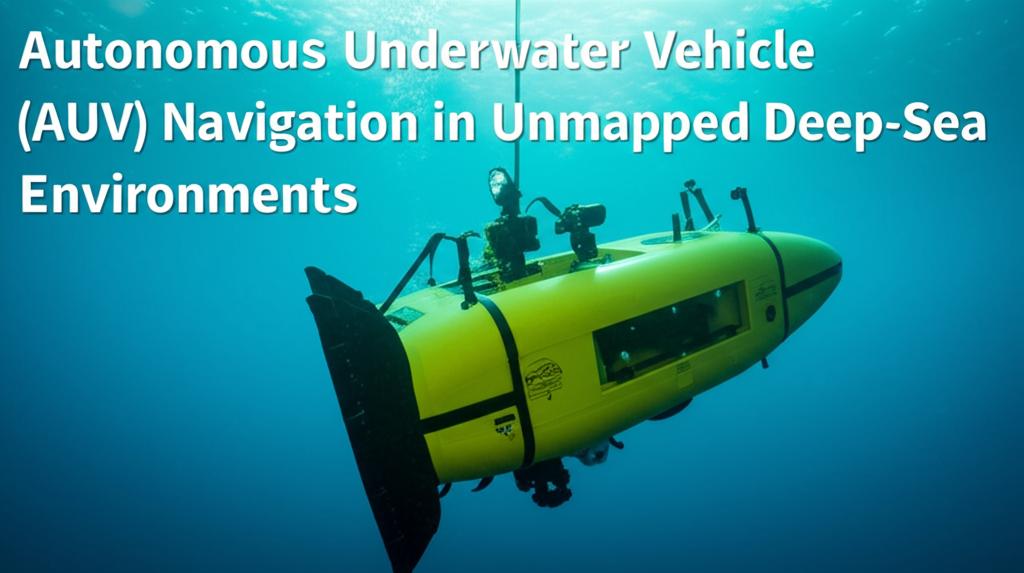Navigating the vast, unmapped expanses of the deep sea presents a formidable challenge for Autonomous Underwater Vehicles (AUVs). The absence of GPS signals,
often distorted or entirely blocked by water, particularly saltwater, necessitates a reliance on innovative technologies to achieve accurate positioning,
speed, and direction. The dynamic and often unpredictable nature of these underwater environments, with their currents, tides, and varied topography, further
complicates precise navigation.
Recent advancements in AUV technology are continually pushing the boundaries of what's possible in underwater exploration. Improved energy efficiency,
enhanced sensor capabilities, and more intelligent decision-making algorithms are expanding their potential applications. AUVs are increasingly crucial
for scientific research, environmental monitoring, national security, and the emerging field of deep-sea mining.
Key Navigation Technologies and Advancements:- Inertial Navigation Systems (INS): These systems form the bedrock of most AUV navigation, using accelerometers and gyroscopes to track position and
orientation. However, INS are prone to drift over time, accumulating errors that require correction.
- Doppler Velocity Logs (DVLs): DVLs are widely used sensors that measure velocity by emitting sound waves and analyzing the Doppler shift of their
reflections from the seabed or water particles. When the DVL can continuously track the seafloor, navigation deviation can be as low as 0.05% of the
total distance traveled.
- Acoustic Positioning Systems: These systems, such as Long Baseline (LBL), Short Baseline (SBL), and Ultra-Short Baseline (USBL), use sound waves
to determine an AUV's position relative to transponders. USBL, for instance, can be used to update an AUV's navigation on descent until the DVL locks
onto the seafloor. Innovative concepts like Synthetic Long Baseline® (SLBL) are extending high-accuracy navigation to deep-sea applications using a
single acoustic transponder as a fixed reference point.
- Sonar Mapping and Terrain-Aided Navigation (TAN): AUVs often employ various sonar systems (like side-scan sonar, multibeam echosounders, and
sub-bottom profilers) to create detailed maps of the seafloor. TAN techniques then use these generated maps, or pre-existing bathymetric data when
available, to help the AUV determine its location by matching its sensor readings to the known terrain. This is particularly useful in areas where
GPS is unavailable.
- Simultaneous Localization and Mapping (SLAM): SLAM algorithms allow AUVs to build a map of an unknown environment while simultaneously keeping track
of their position within that map. This is vital for truly autonomous exploration in unmapped regions. Research is ongoing to develop robust SLAM
techniques specifically for GPS-denied underwater environments. Cooperative SLAM, involving multiple AUVs, is also being explored to improve mapping
efficiency and accuracy.
- Artificial Intelligence (AI) and Machine Learning (ML): AI and ML are transforming AUV navigation. These technologies enable AUVs to:
Learn from their environment: ML algorithms allow AUVs to adapt to changing conditions, optimize routes, and avoid obstacles based on past
experiences and real-time sensor data.
Improve decision-making: AI-powered AUVs can make intelligent decisions in real-time, enhancing their autonomy and operational efficiency.
Enhance sensor data processing: AI can rapidly process and analyze vast amounts of data collected by various sensors, aiding in object
recognition and feature identification.
Enable autonomous hazard avoidance: Systems similar to those used on the Mars Perseverance rover, involving Terrain Relative Navigation (TRN),
are being adapted for AUVs to autonomously sense their location and avoid hazards.
- Non-Traditional Navigation Methods: Development is ongoing for methods like gravity field and geomagnetic field positioning and navigation, which could
offer high-precision, high-efficiency, and high-reliability alternatives for deep-sea AUVs.
- Improved Communication: Advancements in underwater wireless communication, including optical communication in deep-sea environments and long-distance
underwater high-speed communication, are crucial for enhancing the operational range and data transmission capabilities of AUVs, especially for
collaborative missions.
Challenges Remaining:Despite significant progress, navigating unmapped deep-sea environments still poses several challenges:
- Accumulated Errors: The cumulative error that an inertial navigation system experiences over time remains a key challenge, often requiring AUVs to
surface for GPS fixes or rely on acoustic localization beacons, which may not always be feasible or desirable.
- Limited High-Resolution Maps: While TAN is promising, its effectiveness is often limited by the lack of accurate, high-resolution reference maps for
much of the Earth's seafloor. More than 80% of the ocean remains unmapped and unexplored.
- Dynamic and Complex Environments: The ever-changing nature of deep-sea environments makes precise navigation a continuous and complex task.
- Sensor Limitations: Current sensor technology still faces limitations in providing perfect underwater "robot vision," and the time required to collect
and analyze the vast amounts of data can be substantial.
Future Directions:The future of AUV navigation in unmapped deep-sea environments points towards:
- Greater Autonomy: AUVs will possess enhanced abilities for autonomous environment perception, navigation planning, and decision-making.
- Collaborative Operations (Swarm Robotics): Networks of multiple AUVs working together will become more common, allowing for coverage of larger areas,
optimized data collection, and enhanced mission efficiency.
- Deeper Diving Capabilities: Continued development of materials and sealing technologies will enable AUVs to explore even greater depths, potentially
reaching full ocean depth (around 6,000 meters or more).
- Higher Intelligence: The integration of next-generation AI technologies will significantly improve the intelligence level of underwater vehicles,
enhancing their learning capabilities and adaptability.
- Modular Design: AUVs are increasingly being designed with modular payload systems, allowing researchers to customize them with a variety of sensors and
instruments tailored to specific mission objectives.
The ongoing evolution of AUV navigation technologies is paving the way for unprecedented exploration and understanding of our planet's final frontier – the
deep sea. These advancements are not only critical for scientific discovery but also for the sustainable management and utilization of ocean resources.

